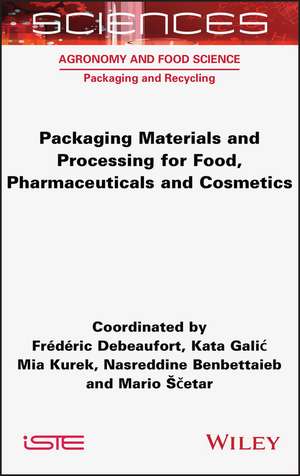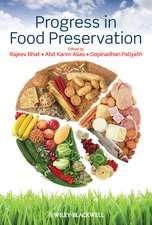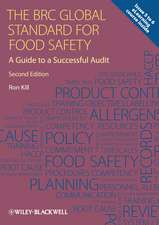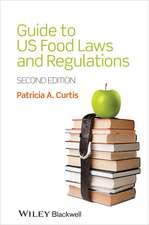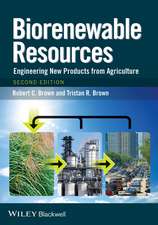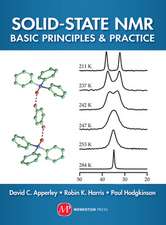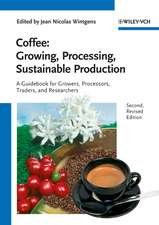Packaging Materials and Processing for Food, Pharmaceuticals and Cosmetics
Autor F Debeauforten Limba Engleză Hardback – 21 iun 2021
Preț: 988.35 lei
Preț vechi: 1086.11 lei
-9% Nou
Puncte Express: 1483
Preț estimativ în valută:
189.15€ • 196.74$ • 156.15£
189.15€ • 196.74$ • 156.15£
Carte tipărită la comandă
Livrare economică 14-28 aprilie
Preluare comenzi: 021 569.72.76
Specificații
ISBN-13: 9781789450392
ISBN-10: 178945039X
Pagini: 400
Dimensiuni: 164 x 239 x 27 mm
Greutate: 0.72 kg
Editura: ISTE Ltd.
Locul publicării:Hoboken, United States
ISBN-10: 178945039X
Pagini: 400
Dimensiuni: 164 x 239 x 27 mm
Greutate: 0.72 kg
Editura: ISTE Ltd.
Locul publicării:Hoboken, United States
Cuprins
Preface xiii
Frédéric Debeaufort, Kata Galic, Mia Kurek, Nasreddine Benbettaieb and Mario S etar
Acknowledgements xv
Frédéric Debeaufort, Kata Galic, Mia Kurek, Nasreddine Benbettaieb and Mario S etar
Introduction to Food Packaging xvii
Frédéric Debeaufort And Kata Galic
Chapter 1. Wood-based Packaging 1
Frédéric Debeaufort
1.1. Introduction 1
1.2. Wood as a raw material for food packaging: characteristics, requirements, limitations and regulations 2
1.3. Pallets 6
1.4. Boxes, crates and trays 9
1.5. Barrels and casks 9
1.6. Wood package-food interactions 13
1.7. References 15
Chapter 2. Papers and Boards 19
Frédéric Debeaufort
2.1. Introduction 19
2.2. Pulp and cellulose extraction for paper-based materials 21
2.2.1. Mechanical and thermomechanical pulping 23
2.2.2. Chemi-mechanical pulping 23
2.2.3. Chemical pulping 24
2.2.4. Recycled paper pulping and non-wood pulping 25
2.2.5. Pulp bleaching 25
2.2.6. Pulp properties and uses 26
2.3. Paper production and properties 27
2.3.1. Paper sheet processing 27
2.3.2. Types of paper for packaging 31
2.3.3. Paper-based bags, sacks and spiral wound containers 32
2.4. Paperboards and containerboards 34
2.4.1. Paperboard processing 34
2.4.2. Paperboard types and properties 35
2.5. Corrugated paperboard 40
2.5.1. Corrugated board history and economy 40
2.5.2. Corrugated board processing and characteristics 40
2.5.3. Corrugated board sustainability 43
2.6. Regulations and safety concerns of papers and boards 43
2.7. References 44
Chapter 3. Glass Packaging 49
Frédéric Debeaufort
3.1. Introduction 49
3.2. Composition and properties of glass 50
3.2.1. Glass composition 50
3.2.2. Chemical and functional properties of glass 53
3.3. Glass manufacturing 56
3.3.1. Collection of raw materials and mixing 57
3.3.2. Melting in furnace 57
3.3.3. Shaping/molding 58
3.3.4. Annealing and surface treatments 62
3.4. Bottle design and terminology 63
3.5. Lifecycle, recycling and safety concerns 67
3.6. References 70
Chapter 4. Metal Packaging 75
Frédéric Debeaufort
4.1. Introduction 75
4.2. Metal packaging types 76
4.3. Composition and properties: metals and alloys 78
4.3.1. Steel-based (iron-based) and tin-plated steel materials 79
4.3.2. Tin-free steel or ECCS (electrolytic chromium oxide-coated steel) materials 83
4.3.3. Stainless steel for food packaging materials 83
4.3.4. Aluminum-based materials 84
4.4. Can manufacturing 86
4.4.1. Three-piece can-making process 86
4.4.2. Two-piece can manufacture 88
4.4.3. Can end making and seaming onto can bodies 91
4.5. Can surface treatments 95
4.6. Food-can interactions 100
4.7. References 101
Chapter 5. Plastics 105
Mario S etar
5.1. Introduction 105
5.2. Plastic materials and processes 106
5.3. Plastic films for packaging 112
5.3.1. Plastic classes 112
5.3.2. Plastic packaging shapes 114
5.4. Properties of plastic packaging 116
5.4.1. General properties of plastic 117
5.4.2. Barrier properties of plastic 118
5.4.3. Food packaging interactions 121
5.5. Plastic packaging innovation 124
5.6. Plastic waste management 125
5.7. Legislation for food contact materials 126
5.8. References 127
Chapter 6. Multilayer Packaging Materials 131
Mario S etar
6.1. Introduction 131
6.2. Multilayer materials and their production 132
6.2.1. Adhesive lamination 133
6.2.2. Extrusion and coextrusion lamination 134
6.2.3. Thermal lamination 135
6.2.4. Metallized films 136
6.3. Properties of laminates 137
6.3.1. Barrier properties 137
6.3.2. Interaction between packaging material and food 140
6.4. Packaging application of laminates 140
6.5. Environmental and waste management issues 142
6.6. References 143
Chapter 7. Bio-based Materials 145
Mia Kurek And Nasreddine Benbettaieb
7.1. Introduction 145
7.2. Definitions 147
7.2.1. Bio-based plastics 147
7.2.2. Biodegradable plastics 148
7.2.3. Compostable materials 151
7.3. Classification of bio-based materials 151
7.3.1. Polymers directly extracted from biomass 151
7.3.2. Polymers produced by chemical synthesis from biomass monomers 164
7.3.3. Polymers produced directly by natural or genetically modified organisms 169
7.3.4. Petrochemical-based polymers 172
7.4. Industrial relevance and future trends 175
7.5. List of abbreviations 176
7.6. References 177
Chapter 8. Active and Intelligent Packaging 183
Nasreddine Benbettaieb
8.1. Introduction 183
8.2. Active packaging 185
8.2.1. Scavenger systems 187
8.2.2. Releaser/emitter systems 196
8.2.3. Other active packaging systems 201
8.3. Intelligent packaging: concepts and commercial applications 202
8.3.1. Indicators 204
8.3.2. Sensors 211
8.3.3. Data carriers 212
8.3.4. Providing more convenience 214
8.3.5. Controlling theft, counterfeiting and tampering 216
8.4. Consumer safety and related regulations 217
8.5. References 218
Chapter 9. Packaging Caps And Closures 223
Kata Galic
9.1. Introduction 223
9.2. Closure types 224
9.2.1. Closures to retain internal pressure 224
9.2.2. Closures to contain and protect contents 225
9.2.3. Closures to maintain a vacuum inside the container 228
9.2.4. Closures to secure contents inside a container 229
9.3. Specialized types of closures 229
9.3.1. Dispensing and metering closures 229
9.3.2. Tamper-evident closures 230
9.3.3. Child-resistant closures 231
9.3.4. Easy-open closures 231
9.4. References 233
Chapter 10. Auxiliary Materials 235
Mia Kurek and Mario S etar
10.1. Introduction 235
10.2. Coatings 236
10.2.1. Coatings on metals 236
10.2.2. Coatings on plastics 239
10.2.3. Coatings on paper and glass 240
10.2.4. Surface treatments and coating application 241
10.3. Adhesives 245
10.4. Printing inks 249
10.5. Interaction between packaging and contents 251
10.5.1. Permeation 251
10.5.2. Migration 252
10.6. Future trends and challenges 254
10.7. References 254
Chapter 11. Food Packaging Methods 257
Kata Galic
11.1. Introduction 257
11.2. Packaging operations 259
11.2.1. Food wrapping 259
11.2.2. Food bagging 261
11.2.3. Form-fill-seal packaging 261
11.2.4. Blister packaging 262
11.3. Packaging for thermally processed food 263
11.3.1. Canning 263
11.3.2. Retortable pouches 266
11.3.3. Aseptic packaging 268
11.3.4. Ohmic heating 270
11.3.5. Infrared treated pre-packaged food 271
11.3.6. Radiofrequency treated pre-packaged food 273
11.3.7. Microwavable packaging 274
11.4. Packaging for non-thermally processed food 276
11.4.1. High hydrostatic pressure 276
11.4.2. Pulsed electric fields 277
11.4.3. Irradiation 279
11.4.4. Pulsed light technology 280
11.5. Packaging with atmosphere modification 281
11.5.1. Vacuum and vacuum skin packaging 282
11.5.2. Inert atmosphere packaging 283
11.5.3. Controlled atmosphere packaging 284
11.5.4. Modified atmosphere packaging 284
11.6. List of abbreviations 290
11.7. References 291
Chapter 12. Packaging Marking and Labeling 301
Mia Kurek
12.1. Introduction 301
12.2. Labeling 302
12.3. Standards 302
12.3.1. Food labeling requirements 303
12.3.2. Food packaging symbols 309
12.4. Material and label production 311
12.4.1. Self-adhesive (pressure-sensitive) labels 312
12.4.2. In-mold labeling 313
12.4.3. Sleeves 313
12.4.4. "Smart" and digital labeling 314
12.5. References 315
Chapter 13. Food Packaging Selection 317
Kata Galic
13.1. Introduction 317
13.2. Food packaging material selection 318
13.2.1. Fresh and chilled food packaging 319
13.2.2. Shelf stable and frozen food packaging 329
13.2.3. Dried food packaging 332
13.2.4. Beverages packaging 333
13.2.5. Snack and confectionary food packaging 336
13.3. List of abbreviations 339
13.4. References 340
List of Authors 347
Index 349
Notă biografică
Frederic Debeaufort is Professor of Food and Packaging Sciences and Technology at the University of Burgundy, France. He is also a researcher at the Food and Wine Physical-Chemistry Lab and President of the national scientific council of ACTIA (Ministry of Agriculture). Kata Galic is Professor of Food Packaging Sciences at the University of Zagreb, Croatia. She is also a member of the EFFoST, CROFoST and the Royal Society of Chemistry. Mia Kurek is Assistant Professor in Food Packaging Sciences at the University of Zagreb, Croatia. Nasreddine Benbettaieb is Assistant Professor in Food and Packaging Physical-Chemistry at the University of Burgundy, France. He is also a researcher at the Food and Wine Physical-Chemistry Lab. Mario Scetar is Assistant Professor in Food Packaging Sciences at the University of Zagreb, Croatia. He is also the President of the Croatian Society of Food Technologists, Biotechnologists and Nutritionists (CROFoST).
